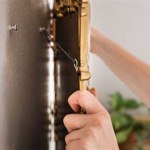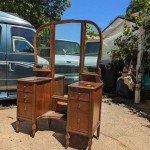How To Build A Vanity Mirror With Lights
A vanity mirror with lights, often referred to as a Hollywood mirror, is a desirable addition to any dressing room, bathroom, or makeup area. The direct and even illumination provided by the surrounding lights minimizes shadows, facilitating precise makeup application, hairstyling, and grooming. Constructing such a mirror can be a rewarding do-it-yourself project, offering customization and cost savings compared to purchasing a pre-made model. This article provides a comprehensive guide on how to build a vanity mirror with lights, covering aspects from material selection to electrical wiring.
Planning and Design Considerations
Before commencing the physical construction, thorough planning is essential. This phase involves determining the desired dimensions of the mirror, the type of lighting to be incorporated, and the overall aesthetic. The size of the mirror should be proportional to the space where it will be placed. Consider the height and width of the table or countertop, as well as the user's height, to ensure comfortable visibility.
The choice of light bulbs is another critical factor. Options include incandescent, LED, and halogen bulbs, each with its own characteristics in terms of light output, color temperature, energy efficiency, and lifespan. LED bulbs are generally preferred for their energy efficiency and long lifespan. Consider the color temperature of the bulbs, measured in Kelvin (K). Warmer temperatures (e.g., 2700K) produce a yellowish light, while cooler temperatures (e.g., 5000K) produce a bluer, more natural light. For makeup application, a color temperature close to daylight (around 5000K) is generally recommended.
The layout of the lights around the mirror is also important. A symmetrical arrangement, with bulbs evenly spaced along the perimeter, typically provides the most balanced illumination. The number of lights will depend on the size of the mirror and the desired level of brightness. A dimmer switch can be integrated into the design to allow for adjustable light intensity.
The frame material should be selected based on aesthetics and durability. Options include wood, metal, and plastic. Wood is a popular choice for its versatility and ease of workability. The frame can be painted, stained, or left natural to match the surrounding décor. Metal frames offer a more modern and sleek appearance, while plastic frames are lightweight and water-resistant.
Materials and Tools Required
The following materials and tools will be required for the project:
*Mirror:
Select a high-quality mirror of the desired dimensions. *Frame Material:
Choose wood, metal, or plastic for the frame. The amount of material needed will depend on the dimensions of the mirror and the desired frame width. *Light Sockets:
Purchase bulb sockets suitable for the chosen type of light bulbs. E26 sockets are commonly used for standard-sized bulbs. *Light Bulbs:
Select the desired type and color temperature of light bulbs. *Wiring:
Use appropriately rated electrical wire for connecting the light sockets. 14-gauge or 16-gauge wire is typically sufficient. *Power Cord:
Obtain a power cord with a plug for connecting the mirror to an electrical outlet. *Wire Connectors:
Use wire connectors (e.g., wire nuts) to securely connect the wires. *Screws:
Select screws suitable for attaching the light sockets to the frame. *Wood Glue (if using a wood frame):
Use wood glue to reinforce the joints of the frame. *Paint or Stain (optional):
If desired, purchase paint or stain to finish the frame. *Clear Coat (optional):
Apply a clear coat to protect the painted or stained frame. *Tools:
* Measuring tape * Pencil * Saw (for cutting the frame material) * Drill * Screwdriver * Wire stripper * Wire cutter * Pliers * Soldering Iron (optional, for soldering wire connections) * Safety glasses * GlovesConstruction Process
The construction process can be broken down into the following steps:
1. Frame Construction:
Measure and cut the frame material according to the desired dimensions. If using wood, cut the pieces at a 45-degree angle at the corners to create a mitered frame. Assemble the frame using wood glue and screws. Clamp the frame together while the glue dries.
2. Socket Installation:
Determine the placement of the light sockets around the frame. Mark the locations for the sockets and drill pilot holes. Attach the sockets to the frame using screws. Ensure the sockets are securely mounted and aligned.
3. Wiring:
Before commencing any wiring, ensure the power cord is disconnected from the power source. Connect the wires from the power cord to the first light socket. Use wire connectors to securely join the wires. Connect the wires from the first socket to the next socket, and continue this process until all the sockets are wired together. Ensure that all connections are secure and insulated.
4. Mirror Installation:
Carefully place the mirror into the frame. Secure the mirror in place using mirror clips or adhesive. Ensure the mirror is properly aligned and centered within the frame.
5. Testing:
Once the wiring and mirror installation are complete, connect the power cord to an electrical outlet. Test the light sockets to ensure they are functioning properly. If any problems are encountered, disconnect the power cord and re-examine the wiring.
6. Finishing (Optional):
If desired, paint or stain the frame to match the surrounding décor. Apply a clear coat to protect the painted or stained finish. Allow the paint, stain, or clear coat to dry completely before using the mirror.Safety Precautions
Electrical safety is paramount when building a vanity mirror with lights. Adherence to all applicable electrical codes and safety regulations is crucial. Always disconnect the power cord from the electrical outlet before commencing any wiring. Use appropriately rated electrical wire and connectors. Ensure that all connections are secure and insulated. If unfamiliar with electrical wiring, consult a qualified electrician. Wear safety glasses and gloves to protect your eyes and hands during the construction process. Use power tools with caution and follow the manufacturer's instructions.
Detailed Wiring Instructions
The wiring of the vanity mirror is arguably the most crucial and potentially hazardous step. A thorough understanding of basic electrical principles is highly recommended before proceeding. This section provides a detailed, step-by-step guide for wiring the light sockets.
First, identify the wires within the power cord. Typically, there will be a black wire (hot), a white wire (neutral), and a green or bare wire (ground). These wires will connect to the corresponding terminals on the first light socket.
Using wire strippers, carefully remove approximately ½ inch of insulation from the ends of each wire. Be careful not to nick or damage the copper strands. Twist the exposed strands of each wire to ensure a solid connection.
Connect the black wire from the power cord to the hot terminal on the first light socket. This terminal is often marked with an "L" or a brass-colored screw. Connect the white wire from the power cord to the neutral terminal on the first light socket. This terminal is often marked with an "N" or a silver-colored screw. Connect the green or bare wire from the power cord to the ground terminal on the first light socket. This terminal is often marked with a ground symbol or a green screw.
Secure the wires to the terminals by tightening the screws. Ensure the connections are tight to prevent loose wires, which can cause arcing or fire hazards.
Next, connect the wires from the first light socket to the second light socket. Use similar wire of the same gauge as the power cord. Connect the black wire from the first socket to the hot terminal on the second socket. Connect the white wire from the first socket to the neutral terminal on the second socket. Connect the green or bare wire from the first socket to the ground terminal on the second socket.
Repeat this process for all remaining light sockets, ensuring that each socket is wired in parallel. This means that each socket receives the full voltage from the power source. Wiring the sockets in series would result in a lower voltage at each socket, potentially dimming the lights.
Once all the sockets are wired, carefully tuck the wires into the frame. Use wire staples or clips to secure the wires and prevent them from interfering with the mirror. Double-check all connections to ensure they are secure and insulated.
Finally, before connecting the power cord to an electrical outlet, use a multimeter to test the continuity of the circuit. This will help identify any short circuits or wiring errors. If any problems are detected, disconnect the power cord and re-examine the wiring.
Troubleshooting
If the lights do not turn on after connecting the power cord, the following troubleshooting steps can be taken:
*Check the power cord:
Ensure the power cord is properly plugged into an electrical outlet and that the outlet is functioning correctly. Test the outlet with another device to confirm it is providing power. *Check the light bulbs:
Ensure the light bulbs are properly installed in the sockets and that they are not burned out. Replace any burned-out bulbs with new ones. *Check the wiring:
Examine the wiring connections to ensure they are secure and that no wires are loose or disconnected. Tighten any loose connections and re-secure any disconnected wires. *Check the circuit breaker:
If the circuit breaker has tripped, reset it. If the circuit breaker trips again immediately after being reset, there may be a short circuit in the wiring. Disconnect the power cord and re-examine the wiring for any potential shorts. *Check the dimmer switch (if applicable):
If the mirror is equipped with a dimmer switch, ensure the dimmer switch is set to an appropriate level. Test the dimmer switch by adjusting the knob or slider to different positions.If the lights flicker or are dim, the following troubleshooting steps can be taken:
*Check the light bulbs:
Ensure the light bulbs are compatible with the sockets and that they are not nearing the end of their lifespan. Replace any old or incompatible bulbs with new ones. *Check the wiring:
Examine the wiring connections to ensure they are tight and that there are no loose connections. Tighten any loose connections and re-secure any disconnected wires. *Check the dimmer switch (if applicable):
An incompatible dimmer switch can cause flickering or dimming. Ensure the dimmer switch is compatible with the type of light bulbs being used. Consider replacing the dimmer switch with a compatible model.
Gorgeous Diy Light Up Vanity Mirrors

10 Diy Vanity Mirror Projects That Show You In A Diffe Light

10 Diy Vanity Mirror Projects That Show You In A Diffe Light

Diy Light Up Vanity Mirrors You Can Make Ohmeohmy Blog

Diy Make Up Mirror With Lights Instructables

Diy Vanity Mirror With Lights Under 150

Modern Wood And Led Vanity Mirror Diy With Lights Makeup

How To Make A Diy Makeup Vanity With Hollywood Lighted Mirror

Diy Light Up Vanity Mirrors You Can Make Ohmeohmy Blog

Diy Vanity Mirror With Lights Under 150








